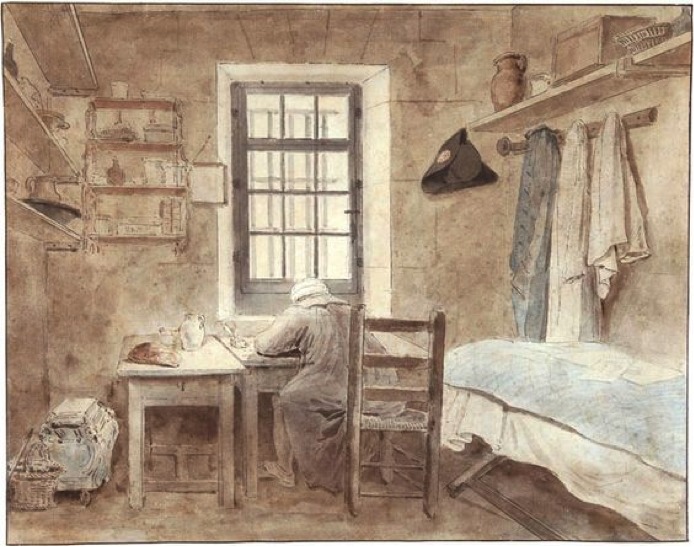Robert during the French Revolution

Hubert Robert, An Inmate of Saint-Lazare Prison, 1794, black ink and watercolor (Private Collection, New York, New York)
Despite his reputation as a painter for the upper classes, Robert chose to stay in Paris during the French Revolution. He lived on the outskirts of the city in Auteuil with his wife and continued to work on commissions for aristocrats and hold official positions. He even maintained cordial relations with some of his more activist acquaintances.1
Hubert was eventually arrested in October of 1793 under the Law of Suspects “for his well-known lack of patriotism” and his “links to aristocrats.”2 The official reasoning behind his arrest, however, was that Robert had failed to renew his “carte de civisme,” or his certificate of good citizenship. Nine people, including the bookseller François Jean Baudouin (1759-1835), signed his arrest warrant.
Robert spent three months in Saint-Pélagie and after that, six months in Saint-Lazare. His imprisonment at Saint-Lazare was apparently quite lax, as he was given art supplies to draw and was also allowed to visit other internees in the prison.3 As a result, Robert was able to produce a large number of paintings, watercolors, gouaches, and painted plates during his internment.
Paula Rea Radisich argues in Hubert Robert: Painted Spaces of the Englightenment that the works Robert produced in prison were “…political statements in which the artist’s means of expression derives from the visual conventions of fine art."4 Indeed, Robert may have been making a political statement in his work An Inmate of Saint-Lazare Prison (1794), which prominently features a hat with the tricolor cockade that had become a symbol of the Revolution in 1789.5 It is also possible, however, that Robert, who maintained a mostly nonpartisan attitude throughout his career, was simply using the symbol of patriotism to fit in and avoid further attention or suspicion. A letter that he wrote to the National Convention in February 1794 further supports this idea of the artist’s willingness to act as a political chameleon. In the letter, Robert offered two sketches depicting scenes from the Revolution in exchange for his freedom.6 Clearly, he was willing to adapt a revolutionary attitude if it meant that he would be released from Saint-Lazare. Though the exchange was never executed, Robert was eventually granted his freedom in August 1794.
SYL
_____________________________________________________________________________________
1Margaret Grasselli and Yuriko Jackall, Hubert Robert, (Washington, D.C: National Gallery of Art, 2016), 249.
2Catherine Voiriot, “A Driven Yet Most Amiable Man,” in Hubert Robert, ed. Michelle Piranio (Washington, D.C: National Gallery of Art, 2016), 50.
3Grasselli, Hubert Robert, 249.
4Paula Rea Radisich, Hubert Robert: Painted Spaces of the Enlightenment, (Cambridge: Cambridge UP, 1998), 121.
5Grasselli, Hubert Robert, 250.
6Ibid., 249.